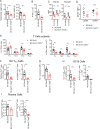B cell OX40L supports T follicular helper cell development and contributes to SLE pathogenesis
- PMID: 28818832
- PMCID: PMC5705841
- DOI: 10.1136/annrheumdis-2017-211499
B cell OX40L supports T follicular helper cell development and contributes to SLE pathogenesis
Abstract
Objectives: TNFSF4 (encodes OX40L) is a susceptibility locus for systemic lupus erythematosus (SLE). Risk alleles increase TNFSF4 expression in cell lines, but the mechanism linking this effect to disease is unclear, and the OX40L-expressing cell types mediating the risk are not clearly established. Blockade of OX40L has been demonstrated to reduce disease severity in several models of autoimmunity, but not in SLE. We sought to investigate its potential therapeutic role in lupus.
Methods: We used a conditional knockout mouse system to investigate the function of OX40L on B and T lymphocytes in systemic autoimmunity.
Results: Physiologically, OX40L on both B and T cells contributed to the humoral immune response, but B cell OX40L supported the secondary humoral response and antibody affinity maturation. Our data also indicated that loss of B cell OX40L impeded the generation of splenic T follicular helper cells. We further show that in two models of SLE-a spontaneous congenic model and the H2-IAbm12 graft-versus-host-induced model-loss of B cell OX40L ameliorates the autoimmune phenotype. This improvement was, in each case, accompanied by a decline in T follicular helper cell numbers. Importantly, the germline knockout did not exhibit a markedly different phenotype from the B cell knockout in these models.
Conclusions: These findings contribute to a model in which genetically determined increased OX40L expression promotes human SLE by several mechanisms, contingent on its cellular expression. The improvement in pathology in two models of systemic autoimmunity indicates that OX40L is an excellent therapeutic target in SLE.
Keywords: B cells; OX40L; T follicular helper cells; autoantibodies; systemic lupus erythematosus.
© Article author(s) (or their employer(s) unless otherwise stated in the text of the article) 2017. All rights reserved. No commercial use is permitted unless otherwise expressly granted.
Conflict of interest statement
Competing interests: None declared.
Figures





Comment in
-
Systemic lupus erythematosus: OX40L-expressing B cells promote SLE.Nat Rev Rheumatol. 2017 Oct;13(10):572. doi: 10.1038/nrrheum.2017.151. Epub 2017 Sep 7. Nat Rev Rheumatol. 2017. PMID: 28878335 No abstract available.
References
MeSH terms
Substances
Grants and funding
LinkOut - more resources
Full Text Sources
Other Literature Sources
Medical
Molecular Biology Databases

